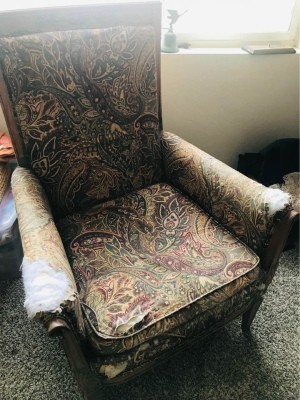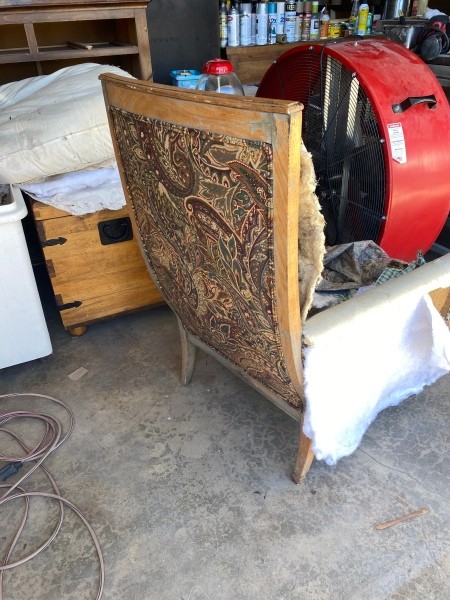 I would like to refurbish this old chair and would like to know more about it. It is stamped on the inside with the word Italy and there is horse hair in the back and feathers in the seat. It has been reupholstered numerous times from what I can tell and I kind of think it may have be reconstructed from more than one chair, just a guess. I am leaning toward a highbred something like a French, Louis, Regency, Bergére, club something or other. What should I do and not do when refinishing it? Any type of fabric more suited for its kind and is it of any value once I am done? I thank anyone that can offer help on this. Kind wishes.
I would like to refurbish this old chair and would like to know more about it. It is stamped on the inside with the word Italy and there is horse hair in the back and feathers in the seat. It has been reupholstered numerous times from what I can tell and I kind of think it may have be reconstructed from more than one chair, just a guess. I am leaning toward a highbred something like a French, Louis, Regency, Bergére, club something or other. What should I do and not do when refinishing it? Any type of fabric more suited for its kind and is it of any value once I am done? I thank anyone that can offer help on this. Kind wishes.

Add your voice! Click below to answer. ThriftyFun is powered by your wisdom!
Without a maker's mark, it is very difficult to determine who made this chair. Most likely it was made in Italy. The style is reminiscent of Bergère: upholstered back and armrests; fitted with a loose, but tailored, seat cushion.
When working with antique furniture, patience is key.
Check the strength of the fasteners. You can disassemble screwed and glued joints. Repair the connections if necessary. Reassemble the antique armchair in sections, adding glue to holes and ends. Until the glue dries, clamp the glued sections with manufactured clamps or devise your own with rope to securely hold the joints.
Any repairs the chair needs should be done before stripping.
It is very important to identify the wood. You can consult a carpenter (it is difficult to do from a photo). Maybe it's walnut or oak.
You will need to use stripper.
Apply finish stripper. When the finish blisters, remove the softened finish with a putty knife. Clean the recesses and carvings with steel wool and detail tools such as a soft brass brush and jute twine. Wash with lacquer thinner.
Upholstery is the last step.
Before you begin, thoroughly inspect the chair. Take photos of it from all angles, including closer detailed photos, so you can put it back together in the same fashion. Also, write down notes on how each piece is attached.
Strip your chair by removing the upholstery pieces layer by layer. Try not to rip any of them as you'll be using them as patterns. Label each piece you remove for your patterns, including how they were attached.
Lay out your new fabric and place the old fabric pieces (wrong side facing upwards) you removed on top of it. Pin the old pieces into place and cut around the pattern, leaving two to three inches of fabric around the original pieces.
About the price.
The price of Antique vintage upholstered inlaid mahogany armchair - lounge reading chair is GBP 145, approximately US $196.66 www.ebay.com/
Attractive Pair Of Directoire Style Carved Upholstered Armchairs is on sale for GBP 495, approximately US $671.34 www.ebay.com/
The price of 1930s Tub Armchair / Tub Chair is GBP 160, approximately US $217 www.ebay.com/
Luxury French Armchair Louis XV Antique Gold Damask was sold for 250,00 £ GBP www.vinterior.co/
This looks like a modified wing chair.
Make sure it is stuffed well, as you dont want it to sag.
Use a tight-woven fabric for durability.
Christie's auction house says that horsehair was used inside antique chair upholstery up until the 19th century. Later pieces may be filled with a combination of horsehair, hay and cotton. Armchairs made after 1830 often have coiled springs, a filling using available substances such as feathers, and webbing or padding beneath the fabric. In the 20th century, synthetic foams replaced the more natural stuffing in many chairs.
There is an interesting article at christies.com "The three 'Rs' of antique furniture - restoration, reupholstery, re-covering" www.christies.com/
I found an unbranded antique Carved Rams Head Armchair that looks a bit like your chair. The seller wrote Style: Louis XVI. This chair is up for sale at an auction and there are no buyers yet. Track at what price it will be sold www.ebay.com/
Add your voice! Click below to answer. ThriftyFun is powered by your wisdom!